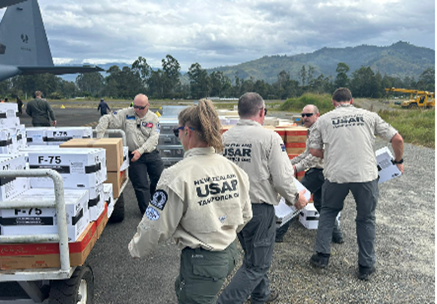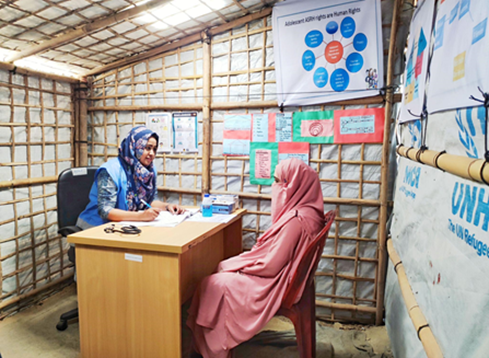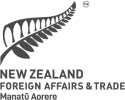On this page
We focus our practical disaster management efforts in the Pacific in particular, and Southeast Asia when required. Countries in these regions are among the most vulnerable to disasters and our closeness means we have the opportunity to be a fast international responder.
Our response systems are designed to be quick and effective and to deliver practical assistance to those most in need.
We also recognise the value of investing in measures that reduce disaster risks and help countries be better prepared for disasters.
Where we focus our humanitarian action
Pacific
The Pacific is the primary geographic focus of New Zealand's humanitarian and disaster management efforts. Pacific countries are our closest partners and we share strong cultural, political and social links. We are also geographically close and can respond quickly with practical assistance in support of Pacific governments after a disaster strikes.

Pacific Island countries are among the most exposed to natural hazards. They are particularly susceptible to cyclones, floods, droughts, volcanic activity, earthquakes and tsunami. The impacts of climate change and unpredictable weather patterns are exacerbating disaster risk. Small island developing states in the Pacific also face disproportionally high risks of extensive economic loss due to their small economies. The impact of multiple disaster events can have devastating consequences on the lives of people and their communities, as well as on entire economies for many years.
While the Pacific is most vulnerable to weather related disasters between November and April (the Southwest Pacific cyclone season), disaster events including earthquakes, volcanic eruption and tsunami can occur at any time.
Southeast Asia
Much of Southeast Asia is also considered to be extremely vulnerable to disasters including storms (typhoons), landslides, earthquakes and tsunami. In this region New Zealand is an effective supporting partner where requested. We provide rapid financial assistance to effective international humanitarian partners and, where we can make an impact, deploy targeted offshore humanitarian deployment capabilities to large-scale emergencies.

Global
The world is facing an unprecedented number of severe and protracted humanitarian emergencies, many caused by conflict. New Zealand will continue to play our part in responding to the world’s most significant humanitarian crises. Our humanitarian assistance in the rest of the world focuses on supporting the coordinated efforts of other international humanitarian responders including the United Nations, the International Red Cross Movement, international non-government organisations and other donors.
How we respond to disasters
New Zealand has excellent capabilities and extensive experience in responding to disasters, building on our domestic expertise and exposure to local natural hazards.
New Zealand’s response to a disaster offshore depends on identified needs at the time and requests from the affected country government. New Zealand adopts a partnership approach to disaster responses. This includes a ‘whole of government’ commitment and working closely with non-government organisations, the United Nations, the private sector and other countries.
Some examples of New Zealand assistance include:
- Providing essential relief supplies such as tarpaulins, shelter kits, hygiene kits, water bottles and mother and infant kits
- Deploying medical assistance through specially trained and experienced health specialists in partnership with the Ministry of Health
- Deploying Urban Search and Rescue or Disaster Assistance Response Teams in partnership with Fire and Emergency New Zealand (FENZ)
- Deploying experienced Emergency Management personnel to support affected country governments in partnership with New Zealand's National Emergency Management Agency (NEMA)
- Supporting affected country governments with logistical and other technical capabilities in partnership with the New Zealand Defence Force (NZDF)
- Partnering with accredited NGOs or other local or international responders who are delivering practical assistance to affected communities
- Providing financial assistance to the affected Government where appropriate
Our partners
To put our humanitarian assistance into action, we work with a range of partners. These include other governments, New Zealand Government agencies and Crown Research Institutes, NGOs, the United Nations, and private businesses.
New Zealand Government agencies
Through our ‘whole of government’ approach to disaster response in the Pacific, we work with other New Zealand Government agencies including Ministry of Health, New Zealand Defence Force, New Zealand Police, NEMA and FENZ to deploy their capabilities in a disaster response.
New Zealand non-government organisations
New Zealand NGOs are key partners in response and early recovery initiatives in the Pacific. They often have excellent networks and partnerships in affected communities and can provide rapid assistance after a disaster, but also help communities to recover. We have partnerships with 14 New Zealand-based NGOs who are accredited to receive humanitarian funding, and who have partners in the Pacific and strong capabilities to provide relief and early recovery assistance.
Find out more about the New Zealand Disaster Response Partnership Fund
Red Cross
The International Red Cross and Red Crescent Movement is the largest humanitarian network in the world, working in 191 countries through over 16 million volunteers. We partner with the New Zealand Red Cross to respond to disasters in various ways including the deployment of essential relief supplies (such as tarpaulins and blankets) and technical assistance (such as shelter, water and sanitation experts). Our partnership also provides longer term support to Red Cross national societies in the Pacific. We also partner with the International Committee of the Red Cross and the International Federation of Red Cross and Red Crescent Societies in response to significant global events.
Read more about the New Zealand Red Cross’s disaster response work(external link)
Other governments
When delivering practical assistance, we work closely with other countries to ensure that our assistance meets response needs and does not duplicate the assistance provided by others. In the Pacific, we have a particularly close partnership with Australia and France under the FRANZ arrangement. The three partners work closely together to ensure we can use our respective assets and capabilities to the greatest and most useful effect.
United Nations
New Zealand works with the United Nations Office for Humanitarian Affairs (UNOCHA), which is responsible for bringing together humanitarian actors to ensure a coherent response to emergencies such as earthquakes, typhoons or conflict, and to assist affected people when they most need relief or protection. OCHA plays a key role in assessing situations and needs, coordinating responses, and mobilising funds and other resources. OCHA’s office for the Pacific is in Suva, Fiji.
Read more about UNOCHA(external link)
Private sector
Private businesses can play a key role in the immediate response to a disaster and in the recovery phase after a disaster. We engage with the private sector in our offshore responses where it is best placed to meet identified needs and requests.
Read more about how the private sector and individuals can help after a disaster
How we help to reduce risks and prepare for disasters
In addition to responding to disasters when they occur, we also invest in a range of partnerships to help reduce disaster risks and support disaster preparedness in partner countries, with a particular focus on the Pacific.
New Zealand's Humanitarian Action Policy
New Zealand’s Humanitarian Action Policy provides guidance for how we prioritise our international humanitarian action and cooperation. This includes our practical responses, our financial support and our humanitarian diplomacy.
The policy reaffirms that New Zealand’s primary humanitarian focus is support to Pacific governments to implement disaster preparedness, response and early recovery activities. Our second geographic priority is Southeast Asia, followed by the rest of the world. When allocating funding to emergencies outside the Pacific and Southeast Asia we consider the scale and severity of humanitarian needs, protection threats, New Zealand’s presence and engagement and New Zealand public interest.

